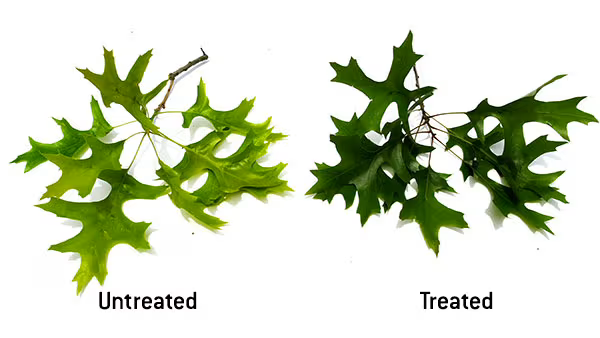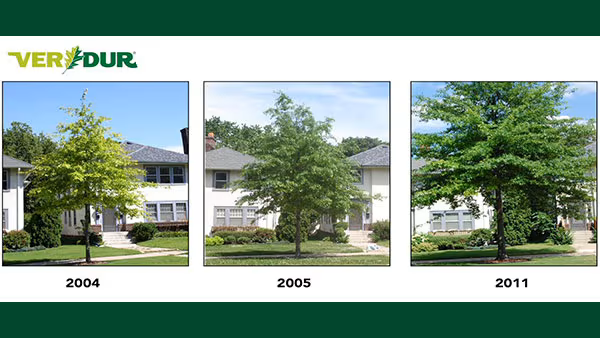Cambistat
-
Cambistat
Travek
Paclobutrazol
Growth Regulator
-
Cambistat® is a tree growth regulator that slows the vegetative growth of trees. Cambistat is used by arborists as the last step in the pruning process as a way to extend trim cycles, increase profitability, and improve safety. Cambistat is also used to promote healthier trees by triggering secondary health benefits.
Cambistat, containing the active ingredient paclobutrazol, is a plant growth regulator that enhances tree health by managing growth patterns. It works by inhibiting the synthesis of gibberellins, hormones responsible for cell elongation and overall growth. This regulation leads to reduced shoot growth and increased root development, resulting in a more compact and structurally balanced tree.
By controlling excessive vertical growth, Cambistat helps trees develop a stronger, more stable structure, which improves their resistance to wind and other environmental stresses. Additionally, the enhanced root system promotes better nutrient and water uptake, contributing to overall tree vitality. Trees treated with Cambistat often exhibit improved health, increased resilience, and better resistance to pests and diseases.
-
Cambistat™ may be applied by soil injection or basal soil drench.
-
In addition to growth control, Cambistat can also be used to:
Increase the longevity of trees growing in stressful conditions
Increase fine root density
Improve drought and heat resistance
Increase disease resistance
Reduce the effects of urban tree stress
-
-
-
Cambistat™ is a plant growth regulator that slows the vegetative growth of plants by inhibiting gibberellin biosynthesis.
Cambistat™ is designed togently and predictably slow the growth of trees. A single application provides a long lasting reduction of vegetative growth, effectively extending the trimming cycle of trees and reducing the amount of woody growth that must be removed.
In addition, use of Cambistat™ may cause other plant growth effects that are beneficial for trees such as increased root density, improved drought and heat resistance, and higher tolerance to insects and diseases.
Cambistat will also benefit trees that are too large for their growing site and increase the longevity of trees growing in stressful environments.
Cambistat™ may be applied by soil injection or basal soil drench.
Cambistat™ may be used on utility rights-of-way, residential areas, urban areas, and other non-crop areas.
-
Iron
-
Verdur
Iron
Liquid Iron
-
Chlorosis can be combatted by providing a readily available source of iron, which is a crucial micronutrient necessary for chlorophyll production and overall plant health.
Iron is a crucial micronutrient that significantly enhances tree health by supporting key physiological functions. It is essential for the synthesis of chlorophyll, the green pigment in leaves responsible for photosynthesis, which enables trees to convert sunlight into energy. Iron also plays a vital role in various enzyme processes, including those involved in respiration and nitrogen metabolism.
Adequate iron levels help trees maintain vibrant green foliage, robust growth, and overall vitality. Iron deficiency often results in chlorosis, where leaves turn yellow while veins remain green, indicating poor chlorophyll production. By ensuring sufficient iron availability, trees can optimize photosynthesis, strengthen their growth, and improve their resistance to stress and diseases.
-
Verdur Iron can be applied via macro-infusion into the roots flares where it is then transported into the canopy.
Liquid Iron can be administered via basal soil drench.
-
-
-
Manganese
-
Manganese Sulfate
Verdur Mn
-
Manganese is a vital micronutrient that plays a key role in several physiological processes essential for tree health. It is crucial for the synthesis of chlorophyll, the pigment responsible for photosynthesis, which allows trees to convert sunlight into energy. Manganese also aids in the activation of enzymes involved in nutrient metabolism, respiration, and the synthesis of amino acids and proteins.
When trees have adequate manganese levels, they exhibit improved growth, stronger root systems, and enhanced resistance to diseases. Manganese deficiency can lead to symptoms such as interveinal chlorosis (yellowing between the veins of new leaves) and poor overall vitality. By ensuring an adequate supply of manganese, trees can maintain optimal photosynthesis and nutrient utilization, promoting robust development and resilience.
-
Verdur Mn can be applied via macro-infusion into the roots flares where it is then transported into the canopy.
Manganese sulfate can be administered via basal soil drench.
-
-
-


